Prior to the electronic era, luthiers often sought innovative ways to boost their acoustic instruments' audibility. In 1899, Augustus Stroh (1828-1914) patented a violin whose bridge was linked to a metal diaphragm and horn. Its extra volume proved effective (though its tone left something to be desired), and Stroh went on to make similarly designed violas, 'cellos, double basses, mandolins and even Hawaiian guitars. Today, while Strohs are occasionally used for special effects, they are regarded as little more than curiosities; however, the resonator-equipped fretted instruments created by John Dopyera (1893-1988) retain a much wider appeal, especially among blues and Country players.
John and his four brothers, Rudy, Louis, Emil (Ed) and Robert, were émigrés from Austro-Hungary who had settled in California with their parents. In the mid-1920s, John and Rudy were running a flourishing banjo-manufacturing business in Los Angeles, and were approached by George Beauchamp (1899-1941), a vaudeville singer and guitarist anxious to be heard better onstage. He asked the Dopyeras to make him a Hawaiian guitar with a Stroh-like, phonograph-style horn to increase its volume - but the results were unsuccessful, and John Dopyera began experimenting with alternative methods of making Beauchamp's guitar louder.
In April 1927, John filed a U.S. patent (granted just over three years later) for his so-called 'tri-cone' system. The prototype guitar into which it was built was made of 'German silver' (an alloy of nickel, copper, and zinc), and had an aluminium, T-shaped bridge, topped with wood where the strings made contact with it. The bridge carried the strings' vibrations to three aluminium diaphragms in the guitar's body, capable of projecting an impressively powerful sound.
Shortly after the patent application was submitted, tri-cone resonator instruments went into production - initially at John and Rudy's Los Angeles shop, and then on a larger scale, under the auspices of a company set up in 1928 by George Beauchamp and the Dopyeras: the National String Instrument Corporation. 1928 also saw the introduction of new guitar with a single resonator cone. Its design was conceived by John Dopyera, but Beauchamp claimed the credit for it, and sought to patent it under his own name. The ensuing dispute led to Dopyera's resignation from National in early 1929; later that year, he formed the Dobro [Dopyera Brothers] Manufacturing Company, where he developed and marketed a rival single-cone resonator guitar.
There was fierce hostility between the two resonator-making firms. Beauchamp warned Dopyera's customers that the new Dobro guitar infringed National's patents, and Dobro retaliated by bringing a $2,000,000 lawsuit against National. The case, a complex one exacerbated by internal wrangling among National's directors, was settled in 1933. Its outcome was favourable to the Dopyeras: Beauchamp was ousted from the National board, and Dobro and National formally merged in 1935. A year later, the National-Dobro Corporation relocated to Chicago; it continued to build instruments there until 1941, when production ceased in the wake of the United States' entry into World War II.
During its relatively brief period of pre-war operation, the National Corporation made a bewilderingly large range of different models, including mandolins and ukuleles as well as Spanish, Hawaiian, and 4-string tenor guitars. These were produced in a variety of decorative 'styles,' some of which had names (e.g. 'Duolian,' 'Triolian'), while others were identified by numbers or letters (Style 1, Style O, Style N, etc.) Our photographs show a cross-section of them, alongside an electric, metal-bodied National lap steel.
NATIONAL STYLE 4 TRI-CONE, 1928
National's 'top-of-the-line' Style 4 guitar was introduced in 1928 and remained in production until 1940. Its elaborate 'chrysanthemum' engraving was designed by George Beauchamp, the company's first General Manager. The model originally sold for $195.
NATIONAL STYLE 2 TRI-CONE, c.1929-30
The Style 2 was one of National's most popular designs, and was the cheapest of its resonator instruments to have a pattern engraved on it ('wild rose,' the work of Rudy Dopyera). This round-necked instrument is comparatively rare; most early National guitars were fitted with square necks for Hawaiian-style playing.

NATIONAL TRIOLIAN WOOD-BODY SINGLE-RESONATOR MODEL, 1928
Not all Nationals were metal-bodied - the company made a good many wooden instruments in the 1930s. The model in our picture, though, is a prototype; about 1,000-1,200 similar examples were produced between 1927-8, mostly without serial numbers. Their design became the basis for the metal Triolian introduced in 1929. This guitar's plywood body and maple neck were constructed to be as dense and vibration-proof as possible. The colourful picture on its back is screen-printed, and was probably applied via a water-slide transfer.
NATIONAL STYLE 3 TRI-CONE, 1929-30
A square-neck model for Hawaiian-style use. Style 3 instruments featured a 'lily-of-the-valley' engraving designed by John Dopyera himself. They were made between 1928 and 1941.

NATIONAL STYLE N SINGLE-RESONATOR MODEL, 1931
This brass-bodied guitar has a mahogany neck, ebony fingerboard, and pearloid-inlaid headstock, and is a more expensive version of the Style O, whose neck and fingerboard were maple, and which had no pearl finish. The instrument shown here has 12 frets clear of its body, but later Style Ns were built with a shortened body and 14-fret access

NATIONAL 'SILVO' ELECTRIC LAP STEEL, c.1937
Following its move to Chicago in 1936, National responded to the growing demand for electric instruments with models like this one. It has a nickel-plated body and an 'ebonoid' coverplate carrying its pickup assembly. National acoustic guitars could be converted to electric operation by having similar 'res-o-lectric' pickup units factory-fitted in place of their resonators.